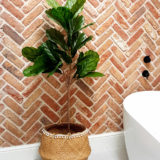When looking to imbue your spaces with the timeless appeal of brickwork, you may come across two terms – brick slips and brick tiles. At first glance, these two may seem similar, making it difficult to discern any distinction. This article aims to unveil the differences between brick slips and brick tiles, helping you make an informed decision for your design projects.
Brick Slips: A Snapshot
Brick slips, also known as brick veneers, are thin cuts of brick, typically around 20-25mm thick. They are used to replicate the appearance of traditional brickwork, offering the aesthetic benefits of bricks without the associated weight and structural implications. Brick slips are primarily used for wall cladding in both interior and exterior applications.
Brick Tiles: An Overview
Brick tiles, on the other hand, are often ceramic tiles that mimic the look of bricks. They are usually thinner than brick slips, typically around 5-10mm thick. Like brick slips, brick tiles are used for wall cladding to achieve a brick-like appearance. However, they are more commonly used in indoor settings, particularly in kitchens and bathrooms.
Brick Slips vs Brick Tiles: The Key Differences
Now, let’s delve into the main differences between brick slips and brick tiles:
1. Material
The primary difference between brick slips and brick tiles lies in the material. Brick slips are made from actual brick, providing an authentic brick appearance and texture. Brick tiles, meanwhile, are generally ceramic or porcelain tiles designed to emulate brick.
2. Thickness
Brick slips are typically thicker than brick tiles. This thickness contributes to the realistic look of brickwork that brick slips provide.
3. Durability and Resistance
Being made from actual brick, brick slips offer a higher level of durability and weather resistance than brick tiles. This makes them suitable for both interior and exterior applications. Brick tiles, while durable in their own right, are best suited for indoor use.
4. Installation
Brick slips and brick tiles follow similar installation methods. However, given their thickness and weight, brick slips may require a stronger adhesive than brick tiles.
Conclusion
While brick slips and brick tiles can both create a brick-like appearance, they differ in material, thickness, durability, and resistance. Brick slips, made from actual brick, offer an authentic look and are suitable for both interior and exterior applications. Brick tiles, being thinner and generally ceramic, are more commonly used indoors. Understanding these differences can help you make the right choice for your specific project requirements.
FAQs
- What are brick slips?
Brick slips, also known as brick veneers, are thin cuts of brick used for wall cladding to replicate the appearance of traditional brickwork. - What are brick tiles?
Brick tiles are usually ceramic or porcelain tiles designed to mimic the look of bricks. They are commonly used for wall cladding in indoor settings. - What is the main difference between brick slips and brick tiles?
The main difference lies in the material. Brick slips are made from actual brick, offering an authentic brick appearance, while brick tiles are generally ceramic or porcelain tiles designed to look like brick.
































